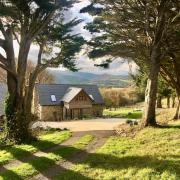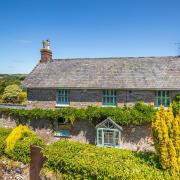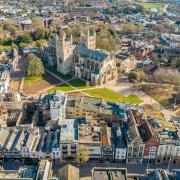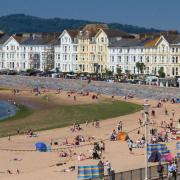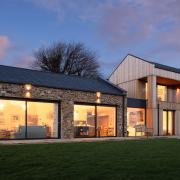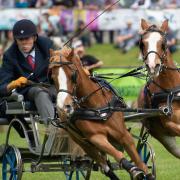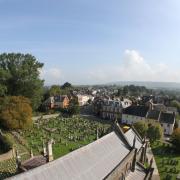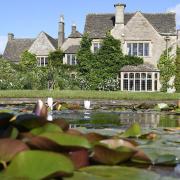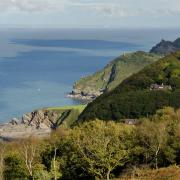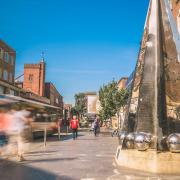When the weather is fine and the tide is right, Jerome Fletcher heads to Blackness Marine where he stores his Venetian rowing boat, Sior Checo.
A bright Sunday morning on the Dart, and four rowers are setting off from the slipway at Blackness Marine heading upriver. It's a large rowing boat; 32ft long, wide-bodied and with sleek lines. However, what draws attention is that the four rowers are standing up and facing forward, leaning on their oars, not pulling. This is not an English boat and the first question most people ask is where is it from? For those with an extensive knowledge of Venetian dialect the name of the boat, Sior Checo, is a give-away. It's a contraction of 'Signor Francesco' (in Venice, boats are male rather than female) and this is a sandolo - not as ornate as a gondola, but no less beautiful. In Venice the sandolo is a family boat, traditionally used for picnics and fishing trips.
What strikes you immediately about rowing a sandolo is the ease with which 500kg of glossy varnished mahogany and marine ply moves through the water. It has a flat bottom and a shallow draft, which makes it very manoeuverable, perfect for negotiating the narrow streets of Venice and the muddy shallows of the Dart. Still, with that weight to shift through the water, it makes sense to take advantage of the tides on the river. Blackness Marine, where the boat is stored, is ideally placed just upriver from East Dittisham. Depending on the tide, we can choose to row downstream to Dartmouth or, as on this occasion, upstream towards Totnes.
With the four of us rowing in unison worthy of the Berlin Philharmonic (well, sort of), Sior Checo glides serenely away from Blackness. The boat remains remarkably stable even in choppy conditions - just as well when you're standing up. The river is wide at this point, almost like a small lake. To our right, buried in an inlet, is the village of Stoke Gabriel. To our left is East Cornworthy, where architect Pedro Sutton keeps another Italian import, a water taxi from Lake Como. The fields are filled with ripening crops, or dotted with sheep like white ticks on the back of a green cow, or in places the deep red of bare South Devon soil shows through.
Rowing la Veneziana means that the wind is a factor. Standing up, we act as a sail and if the wind is in the north, especially where it funnels down the river from Bow Creek, rowing can become quite hard work. Today, a gentle breeze is at our back and it bears us along. This is vital. Whereas English rowing is about sweat and hard work, Venetian rowing is all about making it look elegant and effortless.
As we approach the confluence of the Bow and the Dart, the river narrows and we swing right towards Duncannon. This used to be a small salmon fishing community and, given the activity in the water on summer evenings, you can understand why. There are times when the river seems to boil with fish.
I was introduced to Venetian rowing while I was co-writing a book on food and decadence with a friend of mine, Alex Martin. He was living in Venice and during a stay I went out on the lagoon with him to get a classic view of La Serenissima. Later, back in Oxford, we discovered a rowing club that owned a Venetian boat. Finally we decided to buy a boat of our own, which Alex towed back from Venice on a trailer, nearly burning out the brakes on his car while descending the Alps.
By now we have settled into a gentle rhythm as we row past Point Field at the edge of the Sharpham estate. Often campers here will come to the river's edge to watch this strange craft slide past. This is where we usually have to run the gauntlet of some wit belting out Just one Cornetto'. We smile indulgently as if it's the first time we've heard it.
The river turns left and narrows between the steep wooded hills of the Sharpham estate, which run down to the water's edge, and the meadows on the opposite bank. Here the egrets and herons tread delicately. The cormorants hang their wings out to dry and occasionally the slick black head of a seal will pop up to see what this strange object is. The quiet of the sandolo means that we can often get close to the river creatures without disturbing them. At the same time, one of the most engaging things about this boat is the variety of noises it makes. They range from a rippling gurgle of wavelets running under the flat-bottomed hull to the hearty slap of larger waves, and the rush of the current emerging from the stern to the creaking of the oars in the forcole (the Venetian term for the oar-holders). From time to time, we stop rowing and drift in silence.
Ahead of us appears the white boathouse at Sharpham, where the Italianate house sits above a double bend in the river. The vineyard tumbles down to water meadows populated by geese. We row the final stretch to our destination - the Vineyard Caf�.
Mooring at Sharpham's north quay, we follow a path up the hill to the caf�. It's wonderfully unpretentious - a motley collection of open-air tables, marquees, sheds and what looks like a burger van. And the food that emerges from the van is superb. The dishes are inventive and the ingredients couldn't be fresher - cheese and vegetables come from the Sharpham estate itself. Where supermarkets deal in food miles, here they deal in yards.
At the end of a leisurely lunch, we return to the quay and steer the sandolo back into the flow of the river. We have it all to do again, but with the tide falling and the wind dropping it will be almost effortless. You can't help feeling, with all due respect to Sir Steve and Sir Matthew, when it comes to rowing the Italians have got it right.



